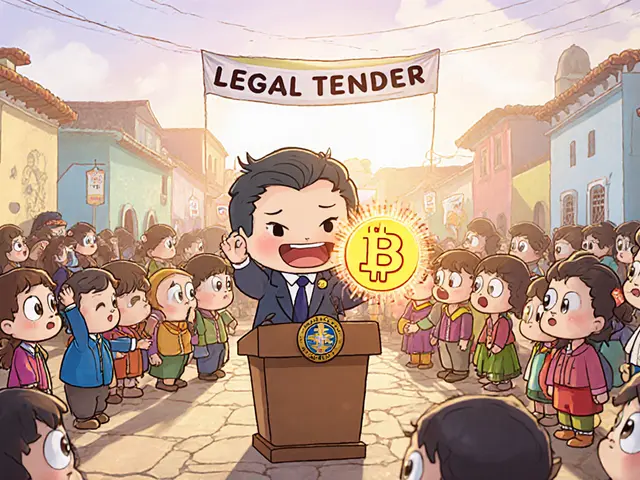Ethereum Layer 2 Gas Fee Calculator
Estimate Your Transaction Cost
Estimated Cost
How This Works
Based on 2025 data: Average fees for different transaction types across L2 networks. Mainnet fees include Ethereum's $0.41 average plus potential congestion spikes.
Picture this: you want to swap $200 worth of tokens on Ethereum and the total cost is $0.30. A few years ago that would have been a laughable fantasy, but thanks to Layer 2 solutions is an off‑chain scaling architecture that processes transactions away from the Ethereum main chain while preserving security guarantees, it’s becoming the new normal.
Key Takeaways
- Average Ethereum gas price fell to $0.41 in February 2025, a four‑year low.
- Rollup‑based L2s (Arbitrum, Optimism, Base) cut fees by roughly 99 % compared with mainnet.
- Bridging introduces an upfront cost, but subsequent L2 activity is dramatically cheaper.
- AI‑driven optimization tools and cross‑chain bridges will shape the next fee‑reduction wave.
- Understanding rollup mechanics, bridge safety, and fee‑estimation tools is essential for any user or developer.
The 2025 Gas Fee Landscape
After years of volatility, Ethereum’s fee market finally steadied. In February 2025 the Ethereum gas fees are the cost users pay to execute smart contract operations on the network, measured in Gwei and converted to USD averaged $0.41 per transaction, down from $15.21 in early‑2023. Daily network fees dropped from a peak of $23 million to $7.5 million, a 70 % reduction.
That drop didn’t happen by accident. Two forces drove it: the transition to Proof of Stake and the rapid adoption of Layer 2 rollups.
Why Proof of Stake Matters
When Ethereum switched to PoS in 2022, the fee‑distribution model changed. Instead of miners, validators are entities that stake ETH to secure the network and receive transaction fees as rewards. The energy savings (≈ 99 % less consumption) made the network more attractive for institutional players, and the lower base‑fee algorithm introduced in EIP‑1559 smoothed out spikes.
But PoS alone didn’t slash fees to sub‑dollar levels. That credit belongs to the Layer 2 wave.
How Layer 2 Solutions Slash Fees
Rollup‑based solutions bundle thousands of transactions, compute a single proof, and post the result on Ethereum. The main chain only verifies the proof, not each individual operation, which slashes the amount of gas needed.
Three design patterns dominate:
- Optimistic Rollups: assume transactions are valid and prove fraud only if challenged. Arbitrum and Optimism fall here.
- ZK Rollups: generate a succinct zero‑knowledge proof for every batch. Base uses a hybrid approach.
- State Channels: keep a private ledger between parties and settle the final state on‑chain.
By moving the heavy lifting off‑chain, the gas each user pays drops from a few dollars to a few cents, sometimes even fractions of a cent for simple transfers.

Leading Rollup Networks in 2025
| Network | Type | Typical Fee (USD) | Security Model | Active Users (M) |
|---|---|---|---|---|
| Arbitrum is an Optimistic Rollup that batches Ethereum txs and posts them every ~7 seconds | Optimistic | $0.02‑$0.05 | Fraud proofs, 7‑day challenge period | 1.2 |
| Optimism is an Optimistic Rollup focused on EVM compatibility and fast finality | Optimistic | $0.01‑$0.04 | Fraud proofs, 7‑day challenge period | 0.9 |
| Base is a ZK‑optimistic hybrid built by Coinbase for low‑fee DeFi and NFT use cases | ZK/Optimistic Hybrid | $0.03‑$0.06 | Validity proofs + fraud‑proof fallback | 0.7 |
All three charge roughly 99 % less than mainnet, but they differ in finality speed, proof type, and ecosystem support. If you care about instant withdrawals, Optimism’s 15‑second finality feels snappier. If you need bullet‑proof mathematical guarantees, Base’s ZK component is appealing.
Practical Steps: Bridging to Layer 2
- Choose a wallet that supports L2. MetaMask, Argent, and Coinbase Wallet all have one‑click bridge options.
- Bridge your assets. Use the official bridge UI (e.g., Arbitrum Bridge). You’ll pay a one‑time Ethereum Mainnet gas fee-usually $1‑$3 for $10‑$20 worth of ETH.
- Confirm the transaction. Check the bridge’s status on Etherscan’s Gas Tracker to make sure you’re not paying an unexpected spike.
- Start transacting on L2. Typical ERC‑20 transfers cost $0.02; DeFi swaps on Uniswap‑V3 on Arbitrum often stay under $0.05.
- When you need to move back. Initiate a withdrawal; the L2→Mainnet step can take 7‑14 days for Optimistic Rollups (you can pay a “fast‑exit” fee to speed it up).
For developers, the Cross‑chain bridges are protocols that allow assets to move between different blockchains or layers while preserving security guarantees like Hop Protocol or Connext can automate the back‑and‑forth flow.
AI‑Powered Gas Optimization Tools
2025 saw a surge of AI‑driven services that predict the cheapest slot to send a transaction. Tools such as Gas Guru or FeeSense ingest real‑time mempool data, forecast congestion, and suggest an optimal gas price. Some even auto‑route a transaction through the cheapest L2 based on the user’s target confirmation time.
In practice, you might set a “max fee $0.05” in the UI, let the AI adjust the gas price every few seconds, and the tool will hop between Arbitrum, Optimism, or Base as needed. The result: sub‑cent fees even during peak market rallies.

Future Outlook: What’s Next for Gas Fees?
Analysts agree on three trends that will keep pushing fees lower:
- More rollup diversity. New ZK rollups (e.g., zkSync Era) promise sub‑millisecond finality with even smaller data blobs.
- Interoperability breakthroughs. The rise of “universal bridges” will let wallets pick the cheapest lane automatically, reducing the need for manual bridging.
- Economic incentives. Ethereum’s upcoming Shanghai‑type upgrades may introduce a fee‑rebate mechanism for high‑frequency L2 users, further shrinking the cost gap.
From a user’s perspective, the biggest win will be predictability. If you can rely on a $0.02‑$0.05 fee for most daily actions, the barrier for new entrants-especially in emerging markets-drops dramatically.
Risks and Things to Watch
Layer 2 isn’t a magic wand. Keep an eye on these:
- Bridge exploits. While most major bridges have survived 2024‑2025, they remain lucrative targets. Use audited bridges and keep only the amount you need for a given session.
- Withdrawal latency. Optimistic rollups still require a challenge window. If you need instant liquidity, consider ZK rollups or use fast‑exit services (at a premium).
- Smart‑contract compatibility. Not every dApp is L2‑ready. Test your contracts on testnet before moving large sums.
By staying informed and using the right tools, you can reap the fee savings without falling into common pitfalls.
Bottom Line
When you combine PoS, rollup engineering, and AI‑powered fee routing, the future of Layer 2 gas fees looks bright. Expect sub‑dollar costs to become the norm, not the exception. If you’re building or trading on Ethereum, mastering L2 is now as essential as learning how to set a wallet password.
What is the biggest factor causing gas fees to drop in 2025?
The widespread adoption of Layer 2 rollups, combined with Ethereum’s Proof‑of‑Stake upgrade, reduced the base fee and moved most computation off‑chain, slashing fees by up to 99 %.
How do I decide between Arbitrum, Optimism, and Base?
Check three things: fee consistency (Arbitrum and Optimism are similar), finality speed (Optimism is fastest), and ecosystem support (Base has strong Coinbase integration). Choose the one that matches your dApp’s compatibility and withdrawal needs.
Do I still pay any gas on Layer 2?
Yes, but it’s a fraction of mainnet fees-typically a few cents for token transfers and under $0.10 for most DeFi swaps.
Can AI tools guarantee the cheapest fee?
They can’t guarantee 100 % lowest fee, but they dramatically improve odds by predicting congestion and auto‑routing across the cheapest L2 in real time.
What should I watch out for when bridging assets?
Ensure the bridge is audited, keep only a small amount on the bridge at any time, and verify the transaction on a block explorer before confirming.




Isabelle Filion
October 23, 2025 AT 09:13One cannot help but marvel at the astonishing hauteur of the so‑called “Layer 2 renaissance”; it is as if the blockchain aristocracy finally discovered how to dress down their fees without relinquishing their self‑appointed aura of exclusivity. Indeed, the genteel dance of optimism and technical jargon is nothing short of a masterclass in pretentiousness, wrapped in the glossy veneer of cost‑efficiency. One might even suspect that the very notion of sub‑cent gas fees is a subtle performance art, designed to placate the masses while preserving the sanctity of the elite validator clubs.
Scott McCalman
October 23, 2025 AT 10:36Wow, the L2 hype is on fire! 🔥 Who would've thought swapping $200 could cost less than a latte? The market is basically yelling “cheaper gas” from the rooftops, and we’re just here to ride the wave. I’m already picturing the memes when the next rollup drops 🚀
PRIYA KUMARI
October 23, 2025 AT 12:00The so‑called “fee reduction” narrative is a smokescreen for reckless optimism. Developers rush to integrate rollups without proper audits, and users get lured by the promise of pennies‑per‑transaction while ignoring the lurking bridge vulnerabilities. This reckless enthusiasm will backfire the moment a single exploit surfaces, and the entire ecosystem will crumble under its own hubris.
Jessica Pence
October 23, 2025 AT 13:23Hey folks, just a heads up – if you're moving assets to Arbitrum or Optimism, double‑check the bridge address before you click confirm. A tiny typo can send your tokens to a black hole, and re‑covering them is a nightmare. Keep only the amount you need for the session, and stay safe.
Mike Cristobal
October 23, 2025 AT 14:46It's disheartening to see people chase cheap gas while ignoring the moral implications of decentralization. We should ask ourselves whether we are supporting a network that truly serves the common good or merely enabling speculative profit. 🤔 Ethical considerations matter as much as technical ones.
BRIAN NDUNG'U
October 23, 2025 AT 16:10Layer 2 solutions represent a pivotal turning point in the evolution of Ethereum, and the community should celebrate this progress with measured optimism. The dramatic drop in average gas fees from over fifteen dollars to mere cents validates years of research and development invested by engineers worldwide. Users now experience unprecedented accessibility, allowing everyday participants to engage with DeFi without prohibitive costs. Moreover, the security guarantees inherited from the Ethereum base chain remain intact, preserving trust in the system. Validators benefit from a more diversified transaction landscape, leading to healthier staking incentives and network stability. Developers enjoy a richer toolkit, leveraging rollup‑specific SDKs to craft faster, cheaper applications. The competitive environment among Arbitrum, Optimism, and Base drives continuous innovation, each seeking to improve latency, finality, and user experience. As adoption grows, we can anticipate network effects that further reduce overhead and streamline onboarding. Bridging solutions, despite their upfront costs, are becoming more user‑friendly, with UI improvements that lower the barrier to entry. AI‑driven fee optimizers add an extra layer of efficiency, dynamically routing transactions to the cheapest path in real time. This synergy of technology stacks paints a hopeful picture for the future of decentralized finance. Community governance mechanisms also stand to gain, as lower fees empower broader participation in proposal voting. Educational resources are expanding, demystifying rollup mechanics for newcomers and fostering a knowledgeable user base. The environmental impact continues to shrink, aligning with broader sustainability goals. Ultimately, the confluence of these factors signals that Ethereum’s resilience is not merely surviving but thriving. Embracing Layer 2 is no longer optional-it is essential for the ecosystem’s sustained growth.
Donnie Bolena
October 23, 2025 AT 17:33What an exciting era!!! L2 rollups are literally reshaping the crypto landscape!!! Imagine swapping tokens for pennies!!! The speed, the savings, the sheer thrill!!! Every developer should jump on this train now!!! 🚂💨
Elizabeth Chatwood
October 23, 2025 AT 18:56i think l2s are cool but watch out for the bridge fees its still a thing
Tom Grimes
October 23, 2025 AT 20:03Honestly, after reading the extensive list of benefits you laid out, I feel compelled to add that the community spirit around L2s is just as important as the tech itself. The way developers share open‑source libraries, the way users help each other on forums, all of that creates a network effect that transcends pure transaction cost savings. It’s not just about numbers; it’s about people collaborating to push the ecosystem forward. The real power lies in the collective enthusiasm that fuels continuous iteration and improvement across the rollup landscape.
del allen
October 23, 2025 AT 21:26Thanks for the tips, really helpful! 😊
Jon Miller
October 23, 2025 AT 22:50Dude, this whole L2 saga feels like the biggest plot twist in crypto history, and I'm here for the ride!
Rebecca Kurz
October 24, 2025 AT 00:13Beware the hidden fees!!! The bridges may be a trap!!! Stay vigilant!!!
Nikhil Chakravarthi Darapu
October 24, 2025 AT 01:36From a sovereign perspective, relying on external rollup providers undermines the autonomy of our digital infrastructure. National development of indigenous scaling solutions should be prioritized to preserve economic independence.
Tiffany Amspacher
October 24, 2025 AT 03:00Isn't it fascinating how the quest for cheap gas mirrors humanity's eternal pursuit of ease? Perhaps the true cost is not measured in dollars, but in the complacency that follows.
Patrick Day
October 24, 2025 AT 04:23They say the fees are lower, but who's really benefiting from all that hidden data extraction?
Jenna Em
October 24, 2025 AT 05:46The future of cheap transactions sounds good, but I wonder if we're just trading one problem for another.
Stephen Rees
October 24, 2025 AT 07:10Maybe the next upgrade will reveal more than we expect.
Katheline Coleman
October 24, 2025 AT 08:33It is evident that the reduction in transaction costs will likely expand user adoption across emerging markets, thereby fostering greater financial inclusivity.
Amy Kember
October 24, 2025 AT 09:56The ecosystem thrives on competition each rollup pushes limits
Evan Holmes
October 24, 2025 AT 11:20Meh.
Anna Kammerer
October 24, 2025 AT 12:43Great, now we can finally afford to trade without breaking the bank-thanks, L2s! Still, keep an eye on bridge security, otherwise it’s a free‑fall.
Mike GLENN
October 24, 2025 AT 14:06Layer 2 technologies have undeniably reshaped the user experience on Ethereum, making everyday interactions feel much lighter. The convenience of paying merely a few cents for swaps lowers the entry barrier for newcomers, which is essential for broader adoption. At the same time, the underlying security model remains anchored to the Ethereum mainnet, preserving the trustless nature of the network. Developers benefit from a richer ecosystem, able to experiment with complex DeFi protocols without worrying about prohibitive gas costs. Moreover, the competitive landscape among various rollups encourages continuous improvements in latency and finality. Users can now choose between optimistic and ZK solutions based on their specific needs, balancing speed with mathematical certainty. The emergence of AI‑driven fee optimizers further refines the process, automatically selecting the cheapest lane in real time. Although bridging still incurs an upfront cost, the overall savings across multiple transactions quickly offset that initial expense. Community education initiatives have also grown, demystifying the intricacies of rollup mechanics for a wider audience. As the technology matures, we can anticipate even more streamlined user interfaces, reducing friction even further. The environmental benefits of reduced on‑chain activity align with broader sustainability goals, making the entire ecosystem greener. In sum, the convergence of these advances paints an optimistic picture for the future of decentralized finance.
Paul Barnes
October 24, 2025 AT 15:30Sure, cheap gas today, hidden centralization tomorrow.
John Lee
October 24, 2025 AT 16:53What a vibrant tapestry of innovation we’re witnessing-each rollup adds a new hue to the Ethereum canvas, enriching the whole picture.
Jireh Edemeka
October 24, 2025 AT 18:16Ah yes, because we’ve definitely solved every scaling problem with a few clever tricks.